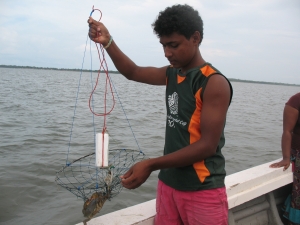Newsroom :: News :: Reintroduction of traditional crab traps increases income of fishers in Kokilai Lagoon, Sri Lanka
Reintroduction of traditional crab traps increases income of fishers in Kokilai Lagoon, Sri Lanka
Location: Kokilai, Sri Lanka . 22nd Mar 2013
The Kokilai lagoon, located on the northeast coastline of Sri Lanka is an estuarine lagoon and is well-known for mud crab (Scylla serrata) and shrimp fisheries.
There are about 300 families in the area who depend on the mud crab fishery. There is a ready market for live, undamaged mud crabs which are over 350g in weight. Crabs caught are purchased and exported to Hong Kong and Singapore by a single exporter P N Fernando who’s collection centre is located near the lagoon. The price paid per crab depends on two factors: weight of the crab and the state of pincer. Crabs below 350g have little or no commercial value. The price goes down by 20-25% if the pincers are not intact or damaged so much so that a 500g crab with a single pincer fetches the same price as 350g crab with both pincers.
Yet, at present, mud crab fishermen use nylon gill nets to catch crabs, with the consequence that pincers are damaged, gravid crabs and other untargeted fauna are also caught and wasted as by-catch.
However, there are about 15 fishermen who use traditional crab traps in the lagoon. Discarded meat of rays is used as the bait. Fishermen lay the floating traps (about 100) every morning and return through the same route about 5-6 hours later collecting the crabs which feed on the bait. The gravid crabs and the small crabs are released to the lagoon. These traditional traps allow the crab to enter and escape without being damaged.
Sewalanka Foundation through a MFF Small Grant Project re-introduced traditional crab traps to 30 fishermen from St Anthony’ Fisheries Society.
As the first step, awareness programmes on sustainable utilization of fishery resources, basic biology of mud crab, construction of traps and proper maintain sales records.
The main intervention was providing traditional crab traps to the beneficiaries (100 per fisher). Material sufficient to make 100 crab traps were distributed through the Society and the beneficiaries constructed the traps on their own.
Use of traditional traps have reduced wastage of fishery resources - no more by-catch. Selective harvest facilitated by traps enables the fishermen to throw the under-weight and gravid crabs back to the lagoon.
Most importantly, as the crabs are caught without any damage to pincers fishermen are able to get higher prices from the exporter. USD 10 for a crab of 500g with both pincers intact. Daily sales records are maintained by the beneficiaries and this assist them in managing their income.
The income from total sales over 6 and 3 month periods is about USD 600 and USD 230 per person respectively. The average monthly income per fishermen is about USD 100 and the increase in household income is 10-25%. The fishery society is now registered as a Fisheries Cooperative society and enjoys benefits as a member. The additional income has no doubt uplifted the living standards of the beneficiaries. These include purchasing basic household furniture, gas stoves, tuition classes for children, improvements to dwellings and paying back loans taken from the village Money Lender.

